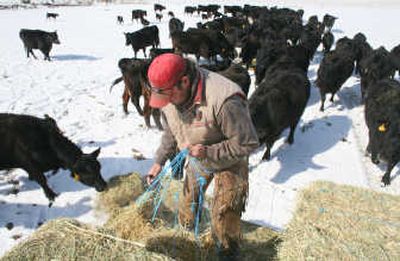Sharing the range

Standing in the middle of the wildlife-land grazing controversy is Kittitas County cattleman Russ Stingley, who’s waiting for state approval to put his cattle out on 18,500 acres over six pastures of rolling shrub-steppe. The state-managed land known as the Skookumchuck – set to be the next battleground for the controversy over grazing on public wildlife lands – is east of Ellensburg and home to thousands of elk. Originally scheduled to take effect April 1, the permit isn’t expected to be approved by the state Fish and Wildlife Commission for another week or so. But every day that passes costs the rancher money.
Like many Eastern Washington cattlemen, Stingley has more cattle than land and relies on lease permits to graze his livestock on state, federal and private land.
“We’re feeding probably seven tons a day to close to 500 head (of cattle). This year, there’s such a shortage of hay – we normally pay $60 to $70 for a ton of hay, and this year we had some brought in last week for $150 – and that’s only if you can find it. I had a (cattleman) calling to see if I knew where he could find some for $200.
Stingley’s permit last year to graze the Whisky Dick Wildlife Area was held up because of state environmental assessment requirements.
The Skookumchuck grazing is part of a coordinated plan involving numerous parties interested in the shrub-steppe hills of eastern Kittitas County, from private recreation groups to the cattle industry and public agencies such as the WDFW and Department of Natural Resources.
It isn’t part of the state’s pilot grazing program in southeastern Washington, but opponents tend to view both in the same light – as an inappropriate use of lands purchased to manage wildlife.
Those same opponents say the only reason Wildlife officials want to allow Stingley’s cattle on the Skookumchuck this spring is that they failed to meet State Environmental Policy Act standards in time to open the adjacent Whisky Dick area, where a grazing permit was to go to Stingley.
“They’re doing this for one reason only, and that is to take care of one rancher,” said Bob Tuck of Selah, a former state Fish and Wildlife commissioner who opposes grazing on state land.
“It’s a perversion of the whole system…,” Tuck said. “I’m sure he’s a fine fellow, but the needs of one rancher should not drive where and what you graze.”
While the Skookumchuck was for years subject to what one former state wildlife lands manager called “a lot of very, very bad grazing practices,” it had long been coveted by the agency.
Its acquisition last fall connected the Whisky Dick and Quilomene wildlife areas, creating a broad landscape of publicly owned shrub-steppe, critical habitat for threatened sage grouse and other species.
The Skookumchuck had been called “the No. 1 critical habitat project” in a state fund to support wildlife and recreation.
Wildlife officials also say the cattle industry’s support was a key factor in recent state acquisitions of large blocks of land that allow that kind of wide-scale management.
“That’s what we’re working towards in a cooperative-type grazing plan, to be able to manage it on a landscape scale,” said Perry Harvester, WDFW regional habitat division supervisor.
The plan calls for allowing Stingley’s cattle to remove no more than 35 percent of the available forage in any of the six pastures in the 29-square-mile area. The rest is to be left as cover for nesting birds, like sage grouse, and forage for deer and elk.
But a catch has developed since the state took over the Skookumchuck.
In one 5,988-acre pasture where Stingley’s cattle are destined to graze, state biologists doing aerial surveys in March counted 979 elk. That’s the most they’ve ever recorded there at that time of year. Typically, they count fewer than 80 elk in the pasture.
Biologists attribute the dramatic increase to a nearby winter road closure two years ago, which reduced human disturbance of the Colockum elk herd.
But what about the disturbance caused by the cattle moving in?
“That’s the big question, isn’t it?” said Jeff Bernatowicz, WDFW wildlife biologist based in Yakima. “Where are (the elk) going to go, and what are they going to find there to eat? And are they going to be running through people’s fences.
“One of the reasons behind all this (managed grazing), in theory, is to create good elk habitat to keep them on state lands longer. The reality is, if you put out cattle on April 1, the elk are most likely going to leave.”
The elk will probably move into the higher-elevation pastures, above the flatter fields preferred by the cattle. They’re accustomed to doing just that, since the Skookumchuck has been heavily grazed for years.
“Historically, the elk were probably being pushed out of there by April anyway,” Bernatowicz said. “But we’ve never had that many elk there, either.”
If the Skookumchuck grazing project doesn’t work – and the grazing worsens forage and ground cover for wildlife, as opponents anticipate – wildlife won’t be the only ones to suffer. So will small cattlemen like Stingley.
If he and other cattle ranchers can’t find ways to remain profitable – with monitored grazing on public lands – the alternative might be much worse.
Some, said Jack Field, executive vice president of the Washington Cattlemen’s Association, may simply opt to sell their private land to developers.
“When done right, grazing is an absolute benefit for both the ranchers and the wildlife, by maintaining those landscapes that surround the public lands,” Field said. “That’s a buffer between the developers and our scenic areas. People would rather have one or two large landowners there than 250 ranchettes.
“And that’s better for the wildlife, too.”